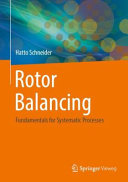

Most ebook files are in PDF format, so you can easily read them using various software such as Foxit Reader or directly on the Google Chrome browser.
Some ebook files are released by publishers in other formats such as .awz, .mobi, .epub, .fb2, etc. You may need to install specific software to read these formats on mobile/PC, such as Calibre.
Please read the tutorial at this link: https://ebookbell.com/faq
We offer FREE conversion to the popular formats you request; however, this may take some time. Therefore, right after payment, please email us, and we will try to provide the service as quickly as possible.
For some exceptional file formats or broken links (if any), please refrain from opening any disputes. Instead, email us first, and we will try to assist within a maximum of 6 hours.
EbookBell Team

4.3
98 reviewsBalancing of rotors is an indispensable process for the quality management, involving many steps from design to maintenance. With many developments of rotors – with new concepts, materials and machining methods – the challenges on balancing processes change. In search for an optimum solution for these complex tasks, no patent remedies will help, but only a sound knowledge of the theoretical background of rotor balancing, of its practical implementation and of the performance of the various balancing systems.
This book is intended to support systematic familiarisation with the subject and ongoing training – in practice as well as in theory.A focus of current ISO Standards development is on errors that occur during balancing – intentionally created, or accidentally generated. They must be properly analysed and taken into account in order to determine the permissible readings for residual unbalances. The acceptance criteria were specified precisely so that the balancing objective – the targeted balancing quality – can be reliably achieved.
Even today, balancing rotors with shaft-elastic behaviour often is carried out following certain established in-house rules. For this reason, the modal approach was further elaborated – partly on the basis of DIN ISO 21940 – Part 12, Supplement 1. The difficult choice of correction planes for the flexural modes is explained also by various examples.